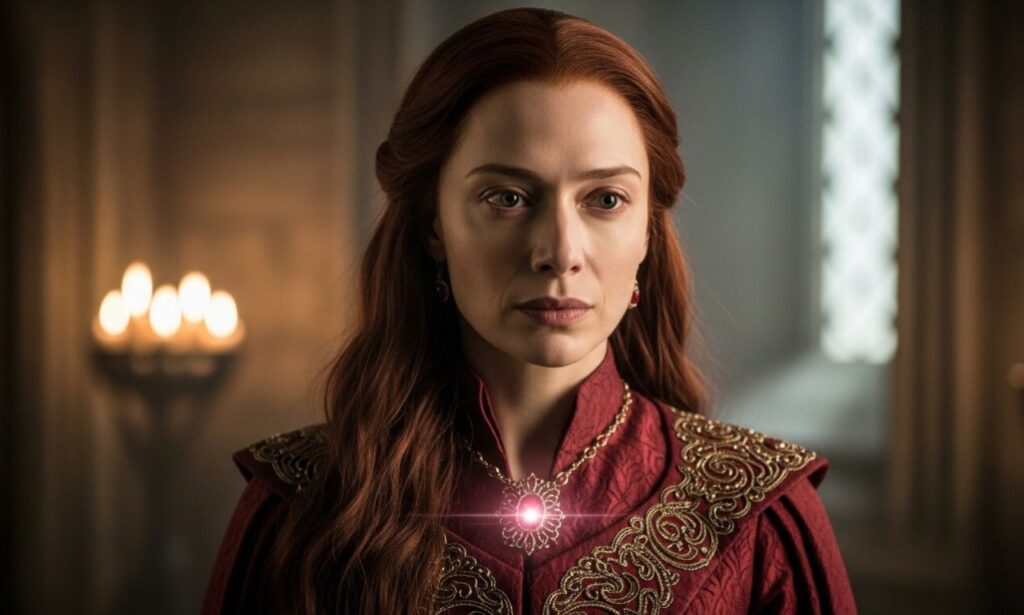In the sprawling world of Westeros, few characters ignite as much debate and intrigue as Melisandre. Cloaked in mystery and steeped in shadows, this enigmatic red priestess captures our attention from her very first appearance. With her fiery hair and piercing gaze, she serves a dual purpose: both an ally to some and a foe to others. As we delve deeper into her story, we uncover layers of complexity that challenge our perceptions of morality, faith, and power. From her unwavering devotion to the Lord of Light to the controversial choices she makes throughout the series, Melisandre is far more than just a magical figure; she’s a catalyst for change in both herself and those around her. Join us on this journey as we peel back the layers of Melisandre’s character—one flame at a time.
Who is Melisandre?
Melisandre, often known as the Red Woman, is a pivotal character in “Game of Thrones.” With her striking red robes and mysterious demeanor, she captures attention wherever she goes.
Born in Asshai, a city steeped in magic and shadows, Melisandre serves the Lord of Light. Her faith shapes her actions and beliefs throughout the series. She possesses powerful abilities that blur the lines between life and death.
Though enigmatic, her motivations are driven by a fervent desire to fulfill prophecies she believes will shape Westeros’s future. Her vision leads to both miraculous feats and grave consequences.
Complex yet compelling, Melisandre’s journey reveals layers of morality intertwined with duty. As viewers delve into her story, they encounter a woman who is far more than just an advisor or priestess; she’s a catalyst for change amidst chaos.
Her Role in the Series
Melisandre plays a pivotal role throughout Game of Thrones. As the red priestess, she wields both power and mystery. Her unwavering faith in R’hllor shapes many key events in Westeros.
From her first appearance, Melisandre captivates viewers with her enigmatic presence. She becomes an advisor to Stannis Baratheon, believing him to be the prophesied hero destined to lead the fight against darkness.
Yet, her influence extends far beyond Stannis. Melisandre’s prophecies guide major decisions that affect countless lives across the realm. Her actions spark intrigue and controversy.
She’s not just a follower of prophecy; she’s also a player within it. The complexity of her character unfolds as she grapples with victory, loss, and moral ambiguity—making viewers question where loyalty truly lies in this brutal world.
Her moments on screen are laden with tension and anticipation, leaving fans eager for more revelations about her true nature and motives.
The Controversial Aspects of Her Character
Melisandre sparks debates among fans for various reasons. Her unwavering faith in the Lord of Light often leads her to make morally ambiguous choices. She is willing to sacrifice individuals for what she perceives as a greater good, which raises eyebrows.
Her role in Stannis Baratheon’s campaign exemplifies this complexity. Many view her manipulation and use of dark magic as treacherous, yet others see it as necessary warfare.
Additionally, Melisandre’s portrayal challenges traditional gender roles within “Game of Thrones.” She’s powerful and influential but often seen through a lens of seduction and deception. This duality creates friction with audiences who may struggle to categorize her simply as a villain or heroine.
Fans also grapple with her prophetic visions that guide characters down perilous paths. Is she genuinely divinely inspired or merely self-serving? These controversies contribute to her status as one of the most intriguing figures in Westeros.
The Power of Prophecy and Religion in Her Storyline
Melisandre’s character is deeply intertwined with themes of prophecy and religion. As a priestess of R’hllor, she embodies the idea that faith can shape reality. Her visions are powerful yet ambiguous, leaving viewers questioning their true meanings.
Throughout the series, Melisandre uses her prophetic abilities to influence key events and characters. She believes wholeheartedly in the significance of “the prince that was promised,” which adds layers to her motivations. This unwavering belief drives many of her actions, leading to both hope and despair.
However, her reliance on prophecy often leads to questionable choices. The moral ambiguity surrounding her methods raises critical questions about faith itself—does it justify any means?
The interplay between destiny and free will plays out through Melisandre’s journey, making her a compelling figure whose beliefs challenge those around her while highlighting the complexities of faith in tumultuous times.
Melisandre’s Relationships and Influence on Other Characters
Melisandre’s influence ripples through many characters in Game of Thrones. Her relationship with Stannis Baratheon stands out as a pivotal one. She is his unwavering supporter, guiding him with visions and prophecies that shape his quest for the Iron Throne.
However, her connection to Jon Snow adds another layer of complexity. Though their paths never truly intertwine until later seasons, Melisandre sees potential in him—a flicker of light amidst darkness.
Then there’s Davos Seaworth, who embodies skepticism toward her methods. Their interactions serve as a moral compass within the series, often highlighting the clash between faith and pragmatism.
She has an undeniable impact on Daenerys Targaryen’s narrative arc. Through whispers of prophecy and fate, Melisandre subtly entwines herself into the fabric of Dany’s storyline without ever directly interacting with her. Each character reflects different facets of power influenced by Melisandre’s enigmatic presence.
The Evolution of Melisandre’s Character
Melisandre’s journey is one of transformation. Initially introduced as a mysterious figure shrouded in shadows, her unwavering faith in the Lord of Light defines her early actions. She embodies absolute conviction, believing fully in the righteousness of her cause.
As the story unfolds, cracks begin to show. Her reliance on prophecy leads to devastating consequences. The burning of innocents and betrayal taints her image in the eyes of many characters—and viewers alike.
Yet there’s depth beneath that façade. Melisandre grapples with doubt and guilt when confronted by failure. This internal struggle adds layers to her character, making her more relatable despite morally ambiguous choices.
By the end, she emerges as a complex blend of zealotry and vulnerability. Each decision reflects growth shaped by past mistakes—making Melisandre one of Game of Thrones’ most intriguing figures throughout its narrative arc.
Fan Theories and Interpretations of Melisandre’s Arc
Melisandre’s arc has sparked a myriad of fan theories, each reflecting the complexity of her character. Some enthusiasts speculate that she is not merely an antagonist but a misunderstood hero destined to play a pivotal role in the battle against darkness.
One popular theory suggests that Melisandre’s visions were misinterpreted. Fans believe her prophecies might have hinted at unexpected allies or outcomes. This idea adds layers to her motivations, painting her as both flawed and insightful.
Another intriguing interpretation highlights her connection to Daenerys Targaryen. Some theorists argue that Melisandre sees Dany as the true embodiment of fire and ice, intertwining their fates in ways yet unseen.
Additionally, discussions around whether Melisandre represents faith versus fanaticism continue to provoke thought among viewers. Her unwavering belief raises questions about morality and sacrifice within the world of Westeros. Each theory opens new avenues for understanding this enigmatic figure in “Game of Thrones.”
The Impact of Melisandre in Game of Thrones
Melisandre’s presence in Game of Thrones is nothing short of transformative. She embodies the complexity of faith intertwined with politics, showcasing how belief can shape destinies. Her unwavering commitment to the Lord of Light drives pivotal plot points.
As a catalyst for major events, she ignites the flames that result in both salvation and destruction. The burning of Stannis’s daughter Shireen sparked outrage among fans, highlighting her moral ambiguity.
Moreover, Melisandre’s relationship with characters like Jon Snow adds layers to her influence. Her prophecy-driven actions create tension and intrigue as they intertwine with others’ fates.
Her character forces viewers to grapple with themes of sacrifice and redemption. Through Melisandre, we see how power can corrupt yet inspire hope simultaneously—a duality that resonates deeply within Westeros’s tumultuous landscape.
Conclusion
Melisandre remains one of the most enigmatic characters in Game of Thrones. Her multifaceted nature captivates audiences and challenges their perceptions of morality, faith, and power. From her fiery red robes to her unwavering belief in the Lord of Light, she embodies a complex interplay between good and evil.
Throughout the series, viewers witness Melisandre’s journey from an apparent villainess to a character with depth and nuance. Her controversial decisions often spark debates among fans about fate versus free will. The prophecies she interprets shape not just her trajectory but also that of other key figures in Westeros.
Moreover, her relationships with characters like Stannis Baratheon and Jon Snow reveal layers to her persona that go beyond mere manipulation or ambition. She is driven by purpose yet haunted by doubt—a reflection of humanity’s struggle with faith.
Fan theories continue to swirl around Melisandre’s arc, suggesting interpretations that range from tragic heroine to a misunderstood savior. Each theory adds another dimension to our understanding of who she is.
The impact of Melisandre on both the narrative and its audience cannot be overstated; she serves as a catalyst for pivotal moments within the story while provoking thought on larger themes surrounding power dynamics in society.
Her legacy lingers long after the credits roll—an enduring testament to how complex narratives can give rise to unforgettable characters who challenge us all.






